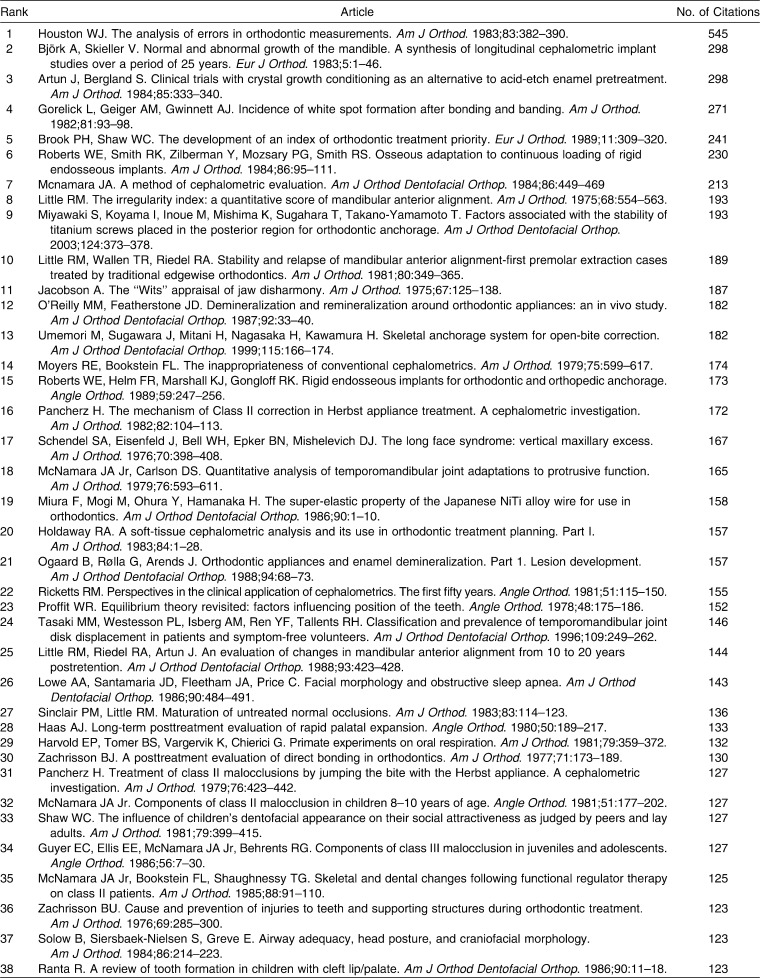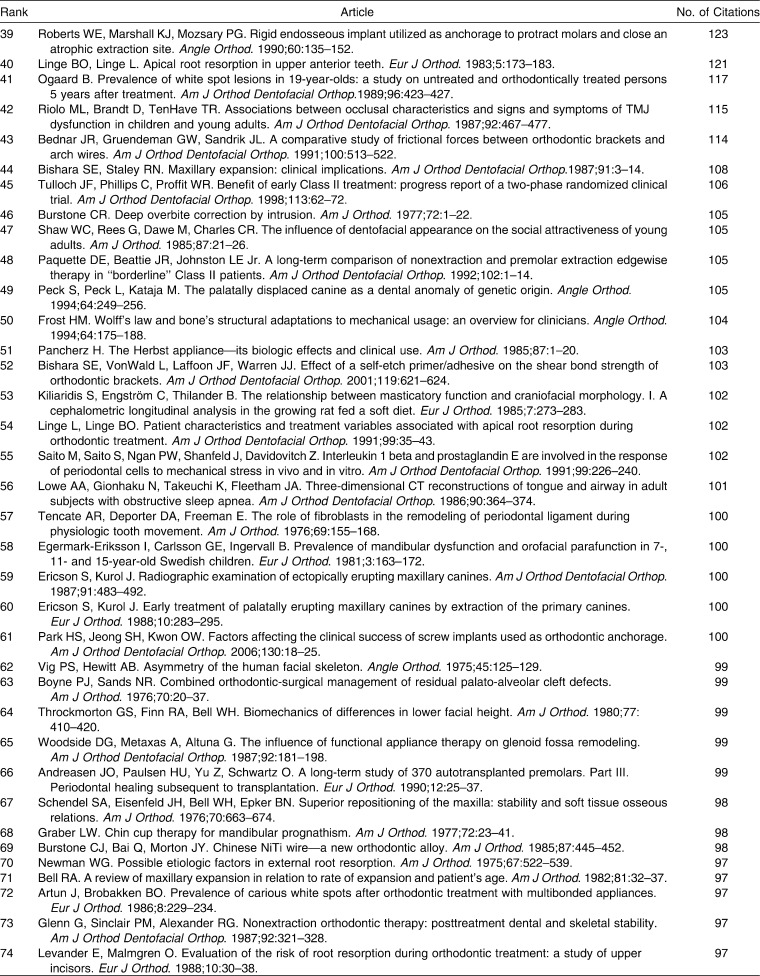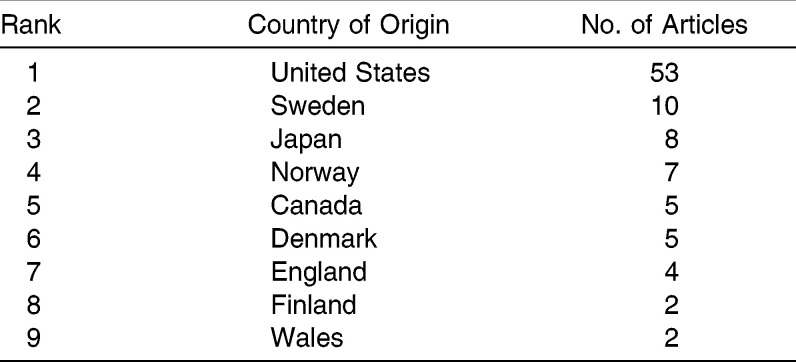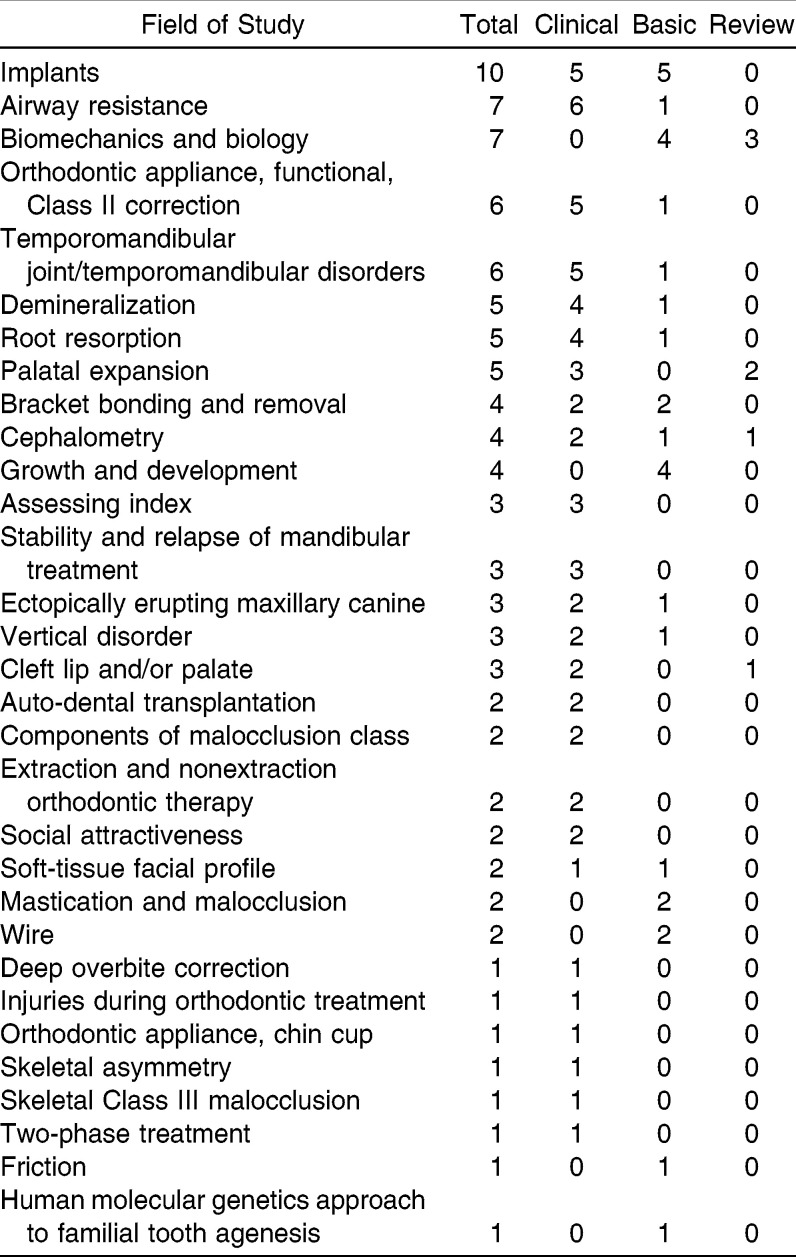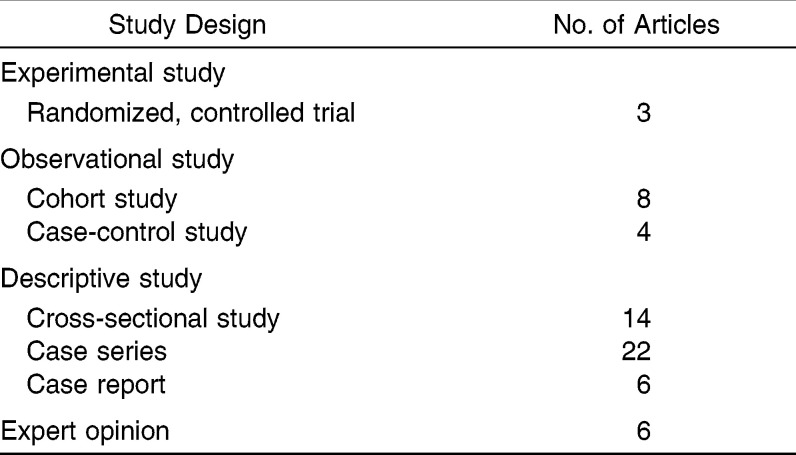Abstract
Objective:
To identify the 100 top-cited articles published in orthodontics journals and to analyze their characteristics to investigate the achievement and development of orthodontics research in past decades.
Methods and Materials:
The Institute for Scientific Information Web of Knowledge Database and the 2011 Journal Citation Report Science Editions were used to retrieve the 100 top-cited articles published in orthodontics journals since 1975. Some basic information was collected by the Analyze Tool on the Web of Science, including citation time, publication title, journal name, publication year, and country and institution of origin. A further study was then performed to determine authorship, article type, field of study, study design, and level of evidence.
Results:
The 100 target articles were retrieved from three journals: American Journal of Orthodontics and Dentofacial Orthopedics (n = 74), The Angle Orthodontist (n = 15), and European Journal of Orthodontics (n = 11). Since 1975, the articles cited 89 to 545 times mainly originated from the United States, and the overwhelming majority of articles were clinical. The most common study design was case series; 40 articles were classified as level IV and 12 as level V evidence.
Conclusions:
The 100 top-cited articles in orthodontics are generally old articles, rarely possessing high-level evidence.
Keywords: Bibliometrics, Citation analysis, Top-cited, Orthodontics
INTRODUCTION
Bibliometrics enables researchers to explore the impact of a specific field. In a certain sense, it is a citation index that is now widely accepted as a measurement of recognition, although it is not a measurement of quality or importance.1
Journal Citation Reports (JCR) provides a systematic and objective means of evaluating the leading global journals critically, with quantifiable, statistical information based on citation data.2 The Web of Science, an intelligent research platform, has access to the world's leading citation databases, making cited reference searching possible.3
Recently, numerous citation analyses and top-cited articles have become available in various specialties, such as dermatology,4 general surgery,5 anesthetics,6 plastic surgery,7 urology,8 neurosurgery,9 rehabilitation,10 ophthalmology,11 orthopedic surgery,12 and endodontics.13 In the past 4 years, more analogous articles have been found in the Science Citation Index. In total, two top-cited articles were published in dentistry. The one in the field of periodontology was published in Journal of Clinical Periodontology14 in 2007, and the other was published in Journal of Endodontics13 in 2011.
Today, an increasing number of studies on bibliometrics or citation analysis in orthodontics are being conducted.15–19 However, no analogous study in the field of orthodontics has appeared domestically and overseas. The purpose of the present study was to identify the 100 top-cited articles published in professional orthodontics journals and analyze their characteristics. The expectation was to provide some references for future studies and clinical practices by categorizing types of studies and grading evidence levels of the articles.
MATERIALS AND METHODS
In early November 2011, we identified the 100 top-cited articles (Table 1) published in professional orthodontics journals since 1975 by the Web of Science. In the 2011 Science Citation Index, 79 journals were listed under the subject category “Dentistry, Oral Surgery & Medicine,” and six professional journals in orthodontics were found. However, three of the professional orthodontics journals were excluded because they did not contribute to the list of top-cited articles. The impact factors of the remaining three professional orthodontics journals were collected from the 2011 JCR. Then, all articles in each given journal were ranked by the number of citations listed on the Web of Science. The 100 top-cited articles were identified among 13,135 articles published in the three major specialized orthodontics journals. The full texts were mainly selected by PubMed, the online Angle Orthodontist, and ScienceDirect. In addition, other methods were used to search for the articles were not found in the aforementioned databases, for example, interlibrary lending and requests for help on the PubMed.cn website (http://paper.pubmed.cn/).
Table 1.
The 100 Top-Cited Articles in Orthodontics
Table 1.
Continued.
Table 1.
Continued.
After they were retrieved from the three orthodontics journals, the 100 top-cited articles were incorporated into an Excel spreadsheet. From the Web of Science, basic information concerning country of origin (based on the first author), institution, year of publication, publication name, and citations of the target articles was collected using the analyze tool. Then, a further study on authorship, article type, field of study, study design, and level of evidence was performed.
According to the method of Anastasia Fardi,13 the types of articles were classified as basic science, clinical research, and review. A clinical study, in contrast to a theoretical or basic science article, is one that pertains to or founded on the observation and treatment of participants.20 It is generally designed to prevent, treat or cure disease by means of drugs, devices or interventions. It includes systematic review, meta-analysis, randomized controlled trial (RCT), cohort study, case-control study, cross-sectional study, case series, case report, and expert opinion. A basic science article is one dedicated to basic science/biomechanics, basic science/animal research, or basic science/in vitro study. In order to describe the fields of the studies, two of us read the full text on the list and summarized respectively. Then the summary sheet was completed by discussion. Level of evidence was evaluated by the Sackett initial and updated rules of evidence, as described by the Oxford Centre for Evidence-Based Medicine in 2009.21 To determine the level of evidence for an article, the first step was to define its study design following the design tree.22 The study whose type can be worked by the study designs above is clinical. The next step was to ascertain the classification of these clinical studies (therapy/prevention, etiology/harm; prognosis; diagnosis; differential diagnosis/symptom prevalence; economic and decision analyses). Next, the level of evidence (level I to V) of clinical articles was graded. The material (article type, field of study, study design, and level of evidence) was collected and classified by two investigators. The data were discussed until a consensus was reached.
RESULTS
Journals and Publication Dates of the Top-Cited articles in Orthodontics
The 100 top-cited articles were published in three journals: 74 were from the American Journal of Orthodontics and Dentofacial Orthopedics, 15 were from The Angle Orthodontist, and 11 were from the European Journal of Orthodontics. Journal title, impact factor, number of citations, and number of articles are listed in Table 2A.
Table 2A.
Journals in Which the 100 Top-Cited Articles in Orthodontics Were Originally Published
The 100 top-cited articles in orthodontics were published from 1975 to 2006. The greatest number of top-cited articles (n = 8) were published in 1976, and seven top-cited articles were published in 1981, 1987, and 1998 each (Table 2B). Articles on the list were divided into three periods, 1975 to 1984 (n = 47), 1985 to 1994 (n = 40), and after 1995 (n = 13). Ninety-three percent of the articles were published before 2000, and only one target article was published after 2005.
Table 2B.
Year in Which the 100 Top-Cited Articles in Orthodontics Were Published
Authors of the Top-Cited Articles in Orthodontics
Authors contributing two or more articles to the list are listed in Table 3. The number of authors of the top-cited articles ranged from 1 to 10, and the most common figures were 1 to 3. According to data statistics, 29 articles had one author, followed by 24 articles with two authors, and 23 articles with three authors. The most frequent first authors of the top-cited articles in orthodontics were J. A. McNamara Jr (n = 4) and R. M. Little (n = 4), both of whom accounted for five articles on the list. Furthermore, W. E. Roberts, H. Pancherz, and A. A. Lowe were each listed as the first author for three articles.
Table 3.
Authors with Two or More Top-Cited Articles in Orthodontics
Countries and Institutions of Origin
According to their countries of origin (based on the first author), more than half of the articles were generated in the United States (n = 53), which led the list (Table 4A). Sweden (n = 10) was the second most productive country, followed by Japan (n = 8) and Norway (n = 7). Canada and Denmark each contributed five articles to the list, and England provided four articles. The 23 leading institutions that provided two or more top-cited articles in orthodontics are listed in Table 4B. The University of Michigan in the United States produced the largest number of orthodontics articles (n = 8), followed by the University of Washington (n = 7), the University of Oslo (n = 6), and the University of Texas (n = 5).
Table 4A.
Country of Origin of the 100 Top-Cited Articles in Orthodontics
Table 4B.
Institution of Origin with Two or More Top-Cited Articles in Orthodontics
Type of Articles and Field of Study
Among the 100 top-cited articles in orthodontics, the overwhelming majority (n = 63) reported clinical experience; 30 articles concerned basic science research and 7 were review articles (Table 5). In the 100 top-cited orthodontics articles, the term “implant” appeared most frequently. Next in the ranking were studies in “biomechanics and biology” and “airway resistance,” followed by “orthodontic appliance, functional, Class II correction” and “temporomandibular joint/temporomandibular disorders.”
Table 5.
Field of Study of the Different Types of Studies
Design of Study and Level of Evidence of the Top-Cited Articles in Orthodontics
The study design of 63 clinical articles among the 100 top-cited orthodontics articles is shown in Table 6. A large number of articles had a case series design (n = 22), and the next most common design was cross-sectional study (n = 14). In addition, eight articles were cohort studies, and only three articles described RCTs.
Table 6.
Study Design of the Clinical Studies
According to the study designs, the levels of evidence of 63 clinical articles are presented in Table 7. Most articles were classified as level IV (n = 40) or level V (n = 12) evidence.
Table 7.
Level of Evidence of the Clinical Studies
DISCUSSION
The period from the 1940s through the 1970s, witnessed significant achievements, developments, and scientific progress in the orthodontics field. The present study, however, only included articles from the Web of Knowledge Database that dated after 1975. So an interesting future study in top-cited orthodontics articles might include articles dating back to 1945, which has already been done for general surgery5 and anesthetics6 articles.
Initially, six journals in orthodontics were selected in the 2011 Science Citation Index, three of which, the Australian Orthodontics Journal, the Korean Journal of Orthodontics, and the Journal of Orofacial Orthodontics Fortschritte der Kieferorthopadie were finally excluded because there is not a top-cited article published in any of them. The three excluded journals contained 104, 191, and 141 articles, respectively, from 1975 to 2011. The maximum citations of the articles published in them merely reached 7, 20, and 11. The target articles were retrieved from three journals: American Journal of Orthodontics and Dentofacial Orthopedics (n = 74), The Angle Orthodontist (n = 15), and the European Journal of Orthodontics (n = 11). In 2010, Shimada23 reported that RCT trials on orthodontics practice in PubMed were published in four orthodontic journals, and the leading journals were American Journal of Orthodontics and Dentofacial Orthopedics and The Angle Orthodontist. Although measures were taken to search the full texts of articles on the list, two were not available. One was published in the American Journal of Orthodontics and Dentofacial Orthopedics in 1981, and the other in the European Journal of Orthodontics in 1983. Callaham et al.24 found that the impact factor of the original publishing journal was the widely effective predictor of citations each year, rather than the methodology or quality of the research. However, as shown in this present study (Table 2), the actual citation of the individual article did not positively related to the impact factor of the journal.
Generally, as shown in the results, the 100 top-cited articles in orthodontics were older articles, and only one target article was published after 2005. It has been reported that scientific articles begin to be cited 1 or 2 years after publication, and reach a maximum citation rate 7 to 10 years later after publication.25 An interval of 10 years to 20 years is needed for maximal recognition of prominent articles in a field.26–28 This may explain why recent articles were cited rarely and appeared scarcely on the list.
Among the 100 top-cited articles in orthodontics, the most common design was case series (n = 22), followed by cross-sectional study (n = 14) (Table 6), indicating that descriptive studies occur most frequently in orthodontics. This might indicated the relative ease of performing simpler study designs in orthodontics. A 2011 study by Pandis et al.29 on articles published in six major clinical dental specialized journals indicated that the dominant design was cross-sectional study. It is recognized that different study design could correspond to different levels of evidence. In the hierarchy of research study designs, systematic reviews, meta-analyses, and RCTs provide the highest quality of evidence, and the lowest grade is applied to case reports and expert opinions. The goal of rating study designs and levels of evidence is to indicate the best available evidence for use in patient care. Actually, the conclusions of descriptive studies can be effectively applied to patient care, although they represent a lower level of evidence (level IV or level V). There was a paucity of articles with high-level evidence in orthodontics. The target articles mainly focused on therapy, and there were no economic studies. However, economic studies are of considerable value because they play a significant role in clinical decision-making.
Among the target articles, there were only 3 RCTs, although RCTs are considered to provide the highest-quality evidence for most clinical or interventional questions. Moreover, few RCTs were found among the top medical articles; for example, there were 14 RCTs in urology8, 9 in rehabilitation10, and 0 in orthopedics12 and endodontology13. There are several possible explanations for the lack of RCTs in orthodontics. First, RCTs are expensive and time consuming to perform. Second, it is difficult to gather large sample and control groups.30 Third, it may be that few years had passed since the publication of the RCTs, so they had not yet reached a significant number of citations. Therefore, it is important for more journals to assess the evidence levels of articles and choose those that provide good evidence, which are most helpful to readers. Furthermore, future studies with a higher level of evidence, if appropriate, may deserve to pursue.
Although we spared no effort to eliminate potential defects in this citation analysis, some limitations related to its inherent problems were inevitable. First and foremost, this survey was restricted to journals with the word “orthodontics” or “orthodontist” in their titles. In other words, some significant orthodontics articles published in other dentistry journals were excluded, and it is possible that these were good- quality articles with a high number of citations. For example, an article about the use of palatal implants for orthodontic anchorage design and clinical application of the orthosystem published by Wehrbein et al. in Clinical Oral Implant Research31 was cited more times (103) than the minimum number of citations (89) in our the list. In addition, a 2003 article on the use of small titanium screws for orthodontic anchorage, published in the Journal of Dental Research,32 was cited 101 times. Second, in the present study, we searched the material only via the Internet, ignoring articles published only in print from the limited material in our library. Without accessing resources available both in print and online, some information will potentially be lost.33 In addition, a number of high-quality articles were published before 1975. Third, time can have a number of effects on the citation ranking of articles. Consequently, the dominant articles in the list could be old studies, whereas some high-quality, innovative, and meaningful articles published in the recent years would be undervalued. In fact, the older articles with a high number of citations are of value in their field. Some of the top-cited articles, for example, may be submitted to organizational reading lists. And most persons in study clubs and journal clubs and students of all ages have been reading the older classical articles year after year. However, there are some good-quality articles among the recent publications, and they deserve more attention. Therefore, it is necessary to evaluate the quality of the new articles, for example, assessing an article by grading its level of evidence. Fourth, lack of correction for self-citations by a journal or an author was a great challenge for the citation analysis.
Despite these obvious defects, the data presented here provide insight into the achievement and development of orthodontics research over the past decades.
CONCLUSIONS
To the best of our knowledge, this is the first study of the 100 top-cited articles in the field of orthodontics.
The 100 top-cited articles in orthodontics are generally older articles; 95% were published more than 10 years ago.
The common study design of the top-cited orthodontics articles is descriptive study.
Articles using high-level evidence rarely appear in the 100 top-cited articles in orthodontics.
Acknowledgments
The authors are grateful to Hongying Pan for her inspiring discussions during the preparation of this article and to Professors Binyou Wang, Wenjing Tian, and Yupeng Liu in the Department of Epidemiology, Harbin Medical University, Harbin, China, for their advice and assistance in the statistical analysis.
REFERENCES
- 1.Tsai YL, Lee CC, Chen SC, Yen ZS. Top-cited articles in emergency medicine. Am J Emerg Med. 2006;24:647–654. doi: 10.1016/j.ajem.2006.01.001. [DOI] [PubMed] [Google Scholar]
- 2. Journal citation reports. Available at: http://wokinfo.com/products_tools/analytical/jcr/ Accessed November 2, 2011. [Google Scholar]
- 3. What It Is. Available at: http://wokinfo.com/about/whatitis/ Accessed November 2, 2011. [Google Scholar]
- 4.Stern RS, Arndt KA. Top cited authors in dermatology: a citation study from 24 journals: 1982–1996. Arch Dermatol. 1999;135:299–302. doi: 10.1001/archderm.135.3.299. [DOI] [PubMed] [Google Scholar]
- 5.Paladugu R, Schein M, Gardezi S, Wise L. One hundred citation classics in general surgical journals. World J Surg. 2002;26:1099–1105. doi: 10.1007/s00268-002-6376-7. [DOI] [PubMed] [Google Scholar]
- 6.Baltussen A, Kindler CH. Citation classics in anesthetic journals. Anesth Analg. 2004;98:443–451. doi: 10.1213/01.ANE.0000096185.13474.0A. [DOI] [PubMed] [Google Scholar]
- 7.Loonen MP, Hage JJ, Kon M. Plastic surgery classics: characteristics of 50 top-cited articles in four plastic surgery journals since 1946. Plast Reconstr Surg. 2008;121:320–327. doi: 10.1097/PRS.0b013e31816b13a9. [DOI] [PubMed] [Google Scholar]
- 8.Hennessey K, Afshar K, Macneily AE. The top 100 cited articles in urology. Can Urol Assoc J. 2009;3:293–302. doi: 10.5489/cuaj.1123. [DOI] [PMC free article] [PubMed] [Google Scholar]
- 9.Ponce FA, Lozano AM. Highly cited works in neurosurgery. Part I: the 100 top-cited papers in neurosurgical journals. J Neurosurg. 2010;112:223–232. doi: 10.3171/2009.12.JNS091599. [DOI] [PubMed] [Google Scholar]
- 10.Shadgan B, Roig M, Hajghanbari B, Reid WD. Top-cited articles in rehabilitation. Arch Phys Med Rehabil. 2010;91:806–815. doi: 10.1016/j.apmr.2010.01.011. [DOI] [PubMed] [Google Scholar]
- 11.Ohba N, Nakao K. The 101 most frequently cited articles in ophthalmology journals from 1850 to 1949. Arch Ophthalmol. 2010;128:1610–1617. doi: 10.1001/archophthalmol.2010.308. [DOI] [PubMed] [Google Scholar]
- 12.Lefaivre KA, Shadgan B, O'Brien PJ. 100 most cited articles in orthopaedic surgery. Clin Orthop Relat Res. 2011;469:1487–1497. doi: 10.1007/s11999-010-1604-1. [DOI] [PMC free article] [PubMed] [Google Scholar]
- 13.Fardi A, Kodonas K, Gogos C, Economides N. Top-cited articles in endodontic journals. J Endod. 2011;37:1183–1190. doi: 10.1016/j.joen.2011.05.037. [DOI] [PubMed] [Google Scholar]
- 14.Nieri M, Saletta D, Guidi L, Buti J, Franceschi D, Mauro S, Pini-Prato G. Citation classics in periodontology: a controlled study. J Clin Periodontol. 2007;34:349–358. doi: 10.1111/j.1600-051X.2007.01060.x. [DOI] [PubMed] [Google Scholar]
- 15.Mavropoulos A, Kiliaridis S. Orthodontic literature: an overview of the last 2 decades. Am J Orthod Dentofacial Orthop. 2003;124:30–40. doi: 10.1016/s0889-5406(03)00199-9. [DOI] [PubMed] [Google Scholar]
- 16.Gibson RM, Harrison JE. What are we reading now? An update on the papers published in the orthodontic literature (1999–2008) J Orthod. 2011;38:196–207. doi: 10.1179/14653121141461. [DOI] [PubMed] [Google Scholar]
- 17.Gibson R, Harrison J. What are we reading? An analysis of the orthodontic literature 1999 to 2008. Am J Orthod Dentofacial Orthop. 2011;139:e471–e484. doi: 10.1016/j.ajodo.2010.07.023. [DOI] [PubMed] [Google Scholar]
- 18.Kanavakis G, Spinos P, Polychronopoulou A, Eliades T, Papadopoulos MA, Athanasiou AE. Orthodontic journals with impact factors in perspective: trends in the types of articles and authorship characteristics. Am J Orthod Dentofacial Orthop. 2006;130:516–522. doi: 10.1016/j.ajodo.2005.06.020. [DOI] [PubMed] [Google Scholar]
- 19.Harrison JE, Ashby D, Lennon MA. An analysis of papers published in the British and European journals of orthodontics. Br J Orthod. 1996;23:203–209. doi: 10.1179/bjo.23.3.203. [DOI] [PubMed] [Google Scholar]
- 20. Glossary of Common Site Terms. Available at: http://www.clinicaltrials.gov/ct2/info/glossary Accessed July 20, 2012. [Google Scholar]
- 21.Phillips B, Ball C, Sackett D, Badenoch D, Straus S, Haynes B, Dawes M. Levels of evidence. Available at: http://www.cebm.net/index.aspx?o=1025 Accessed December 3, 2011. [Google Scholar]
- 22. Study designs. Available at: http://www.cebm.net/index.aspx?o=1039#ccs Accessed June 15, 2012. [Google Scholar]
- 23.Shimada T, Takayama H, Nakamura Y. Quantity and quality assessment of randomized controlled trials on orthodontic practice in PubMed. Angle Orthod. 2010;80:525–530. doi: 10.2319/090809-507.1. [DOI] [PMC free article] [PubMed] [Google Scholar]
- 24.Callaham M, Wears RL, Weber E. Journal prestige, publication bias, and other characteristics associated with citation of published studies in peer-reviewed journals. JAMA. 2002;287:2847–2850. doi: 10.1001/jama.287.21.2847. [DOI] [PubMed] [Google Scholar]
- 25.Marx W, Schier H, Wanitschek M. Citation analysis using online databases: feasibilities and shortcomings. Scientometrics. 2001;52:59–82. [Google Scholar]
- 26.Garfield E. 100 Citation classics from the Journal of the American Medical Association. JAMA. 1987;257:52–59. [PubMed] [Google Scholar]
- 27.Hall GM. BJA citation classics 1945–1992. Br J Anaesth. 1998;80:4–6. doi: 10.1093/bja/80.1.4. [DOI] [PubMed] [Google Scholar]
- 28.Albert DM. Analysis of the archives' most frequently cited articles. Arch Ophthalmol. 1988;106:465–470. doi: 10.1001/archopht.1988.01060130511026. [DOI] [PubMed] [Google Scholar]
- 29.Pandis N, Polychronopoulou A, Madianos P, Makou M, Eliades T. Reporting of research quality characteristics of studies published in 6 major clinical dental specialty journals. J Evid Based Dent Pract. 2011;11:75–83. doi: 10.1016/j.jebdp.2010.11.026. [DOI] [PubMed] [Google Scholar]
- 30.Zuccati G, Clauser C, Giorgetti R. Randomized clinical trials in orthodontics: reality, dream, or nightmare. Am J Orthod Dentofacial Orthop. 2009;136:634–637. doi: 10.1016/j.ajodo.2009.06.001. [DOI] [PubMed] [Google Scholar]
- 31.Wehrbein H, Merz BR, Diedrich P, Glatzmaier J. The use of palatal implants for orthodontic anchorage. Design and clinical application of the orthosystem. Clin Oral Implants Res. 1996;7:410–416. doi: 10.1034/j.1600-0501.1996.070416.x. [DOI] [PubMed] [Google Scholar]
- 32.Deguchi T, Takano-Yamamoto T, Kanomi R, Hartsfield JK, Jr, Roberts WE, Garetto LP. The use of small titanium screws for orthodontic anchorage. J Dent Res. 2003;82:377–381. doi: 10.1177/154405910308200510. [DOI] [PubMed] [Google Scholar]
- 33.De Groote SL, Shultz M, Doranski M. Online journals' impact on the citation patterns of medical faculty. J Med Libr Assoc. 2005;93:223–228. [PMC free article] [PubMed] [Google Scholar]



